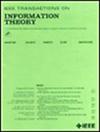Tight Exponential Strong Converse for Source Coding Problem With Encoded Side Information
IF 2.2
3区 计算机科学
Q3 COMPUTER SCIENCE, INFORMATION SYSTEMS
引用次数: 0
Abstract
The source coding problem with encoded side information is considered. A lower bound on the strong converse exponent has been derived by Oohama, but its tightness has not been clarified. In this paper, we derive a tight strong converse exponent. For the special case where the side-information does not exist, we demonstrate that our tight exponent of the Wyner-Ahlswede-Körner (WAK) problem reduces to the known tight expression of that special case while Oohama’s lower bound is strictly loose. The converse part is proved by a judicious use of the change-of-measure argument, which was introduced by Gu and Effros and further developed by Tyagi and Watanabe. A key component of the methodology by Tyagi and Watanabe is the use of soft Markov constraint, which was originally introduced by Oohama, as a penalty term to prove the Markov constraint at the end. A technical innovation of this paper compared to Tyagi and Watanabe is recognizing that the soft Markov constraint is a part of the exponent, rather than a penalty term that should vanish at the end; this recognition enables us to derive the matching achievability bound. In fact, via numerical experiment, we provide evidence that the soft Markov constraint is strictly positive. Compared to Oohama’s derivation of the lower bound, which relies on the single-letterization of a certain moment-generating function, the derivation of our tight exponent only involves manipulations of the Kullback-Leibrer divergence and Shannon entropies. The achievability part is derived by a careful analysis of the type argument; however, unlike the conventional analysis for the achievable rate region, we need to derive the soft Markov constraint in the analysis of the correct probability. Furthermore, we present an application of our derivation of the strong converse exponent to the privacy amplification.求助全文
约1分钟内获得全文
求助全文
来源期刊

IEEE Transactions on Information Theory
工程技术-工程:电子与电气
CiteScore
5.70
自引率
20.00%
发文量
514
审稿时长
12 months
期刊介绍:
The IEEE Transactions on Information Theory is a journal that publishes theoretical and experimental papers concerned with the transmission, processing, and utilization of information. The boundaries of acceptable subject matter are intentionally not sharply delimited. Rather, it is hoped that as the focus of research activity changes, a flexible policy will permit this Transactions to follow suit. Current appropriate topics are best reflected by recent Tables of Contents; they are summarized in the titles of editorial areas that appear on the inside front cover.
 求助内容:
求助内容: 应助结果提醒方式:
应助结果提醒方式:


